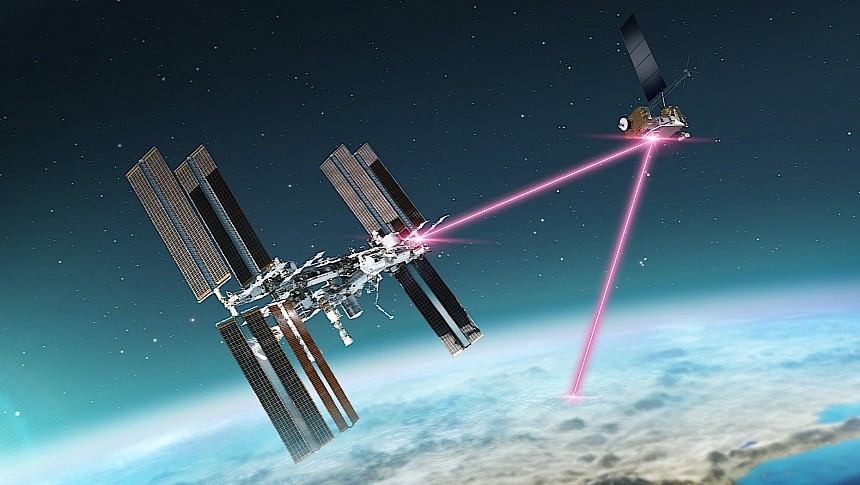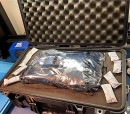Back in May 2023 news broke of the American space agency achieving an important milestone when it comes to space-to-Earth communications: it managed to send back from orbit a staggering 200 gigabits of data per second, the "highest data rate ever achieved by optical communications technology."
The tech that allowed for this milestone to be reached was called TeraByte InfraRed Delivery (TBIRD), a piece of hardware the size of a tissue box installed in a satellite called Pathfinder Technology Demonstrator 3 (PTD-3). And it only opened up NASA's appetite for testing how lasers could help improve communications.
At the moment most of the chatter between Earth and orbit is performed by means of radio technology, a reliable yet not very fast and accommodating way of doing things. By comparison, optical systems (lasers) are infinitely faster and more capable, and a new tech called ILLUMA-T could help implement the tech in a shorter time.
ILLUMA-T stands for Integrated LCRD Low Earth Orbit User Modem and Amplifier Terminal and it's much larger than TBIRD, about the size of a refrigerator. It will be sent up to the International Space Station (ISS) where it will be installed to an external module, the Japanese Experiment Module-Exposed Facility (JEM-EF).
The system will be used in conjunction with the Laser Communications Relay Demonstration (LCRD) that was sent up there back in 2021. This hardware is presently located in geosynchronous orbit at a point 22,000 miles (35,400 km) away from Earth, transmitting data for testing purposes between two ground stations.
ILLUMA-T will be used to beam to the LCRD high-resolution data, including pictures and videos, at a rate of 1.2 gigabits per second. The LCRD will then send that back down to Earth to receivers in Hawaii and California.
The two systems will make NASA's “first two-way, end-to-end laser relay system," and hopes are it will really open the doors to new comms tech to be used for space exploration purposes.
For the moment NASA does not plan to completely remove radio tech from space comms, and plans to use whatever it learns from the use of lasers to complement that. And that's something our world clearly needs, especially in light of the upcoming long-term missions to the Moon and the potential start of the exploration of Mars.
The ILLUMA-T will be on board the Falcon 9 rocket that will perform the 29th SpaceX-run resupply mission to the ISS (CRS 29). At the time of writing the rocket is scheduled to lift off from the Kennedy Space Center in Florida on November 1.
The hardware and its mission in space are handled by the NASA Goddard Space Flight Center and have the backing of the Massachusetts Institute of Technology (MIT). It's not yet clear when the first results of the tests will be made public.
At the moment most of the chatter between Earth and orbit is performed by means of radio technology, a reliable yet not very fast and accommodating way of doing things. By comparison, optical systems (lasers) are infinitely faster and more capable, and a new tech called ILLUMA-T could help implement the tech in a shorter time.
ILLUMA-T stands for Integrated LCRD Low Earth Orbit User Modem and Amplifier Terminal and it's much larger than TBIRD, about the size of a refrigerator. It will be sent up to the International Space Station (ISS) where it will be installed to an external module, the Japanese Experiment Module-Exposed Facility (JEM-EF).
The system will be used in conjunction with the Laser Communications Relay Demonstration (LCRD) that was sent up there back in 2021. This hardware is presently located in geosynchronous orbit at a point 22,000 miles (35,400 km) away from Earth, transmitting data for testing purposes between two ground stations.
ILLUMA-T will be used to beam to the LCRD high-resolution data, including pictures and videos, at a rate of 1.2 gigabits per second. The LCRD will then send that back down to Earth to receivers in Hawaii and California.
The two systems will make NASA's “first two-way, end-to-end laser relay system," and hopes are it will really open the doors to new comms tech to be used for space exploration purposes.
For the moment NASA does not plan to completely remove radio tech from space comms, and plans to use whatever it learns from the use of lasers to complement that. And that's something our world clearly needs, especially in light of the upcoming long-term missions to the Moon and the potential start of the exploration of Mars.
The ILLUMA-T will be on board the Falcon 9 rocket that will perform the 29th SpaceX-run resupply mission to the ISS (CRS 29). At the time of writing the rocket is scheduled to lift off from the Kennedy Space Center in Florida on November 1.
The hardware and its mission in space are handled by the NASA Goddard Space Flight Center and have the backing of the Massachusetts Institute of Technology (MIT). It's not yet clear when the first results of the tests will be made public.








